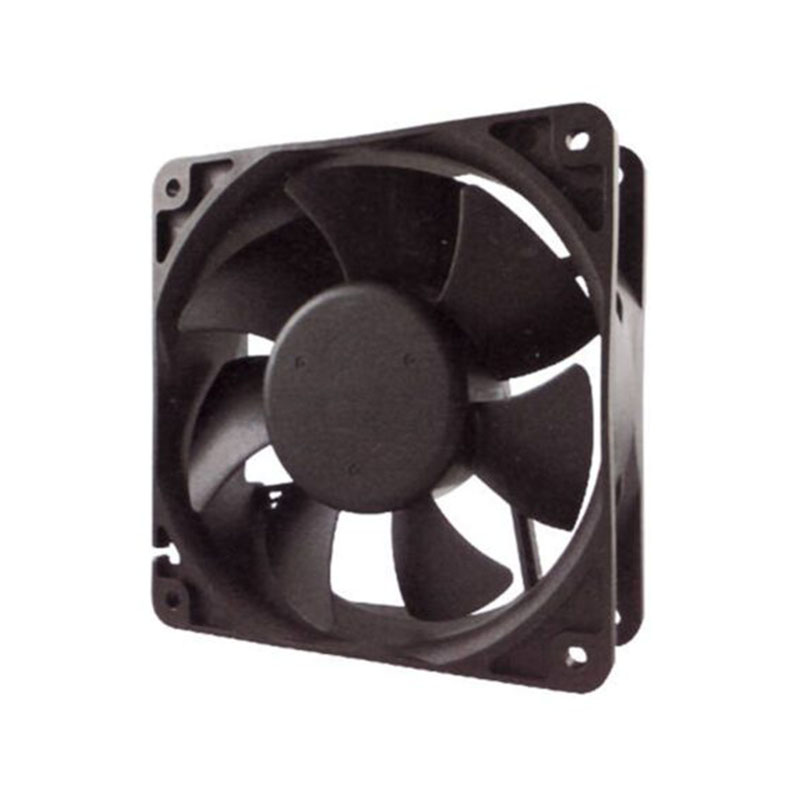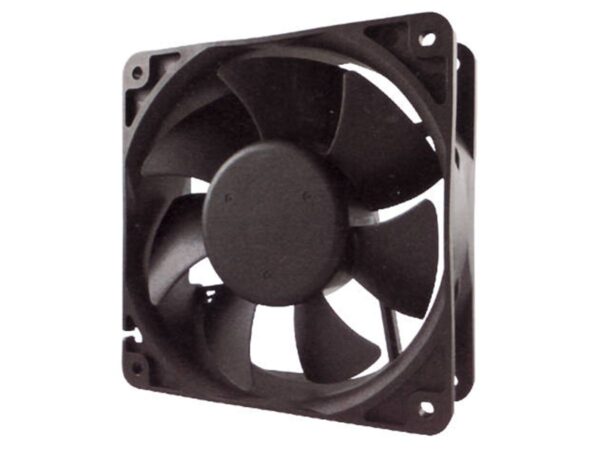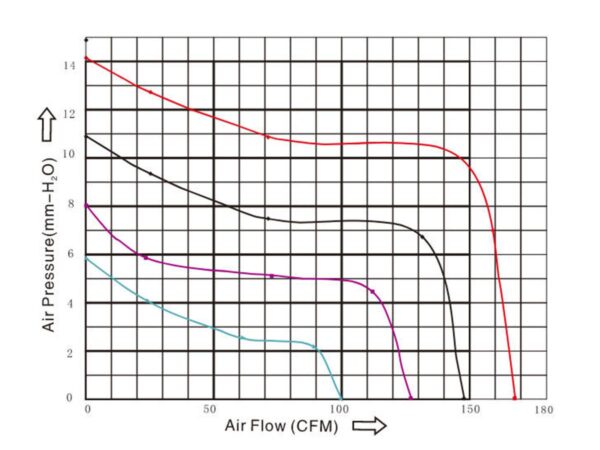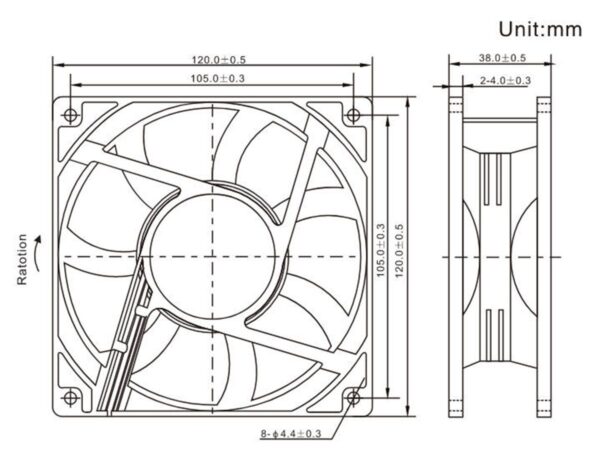


EC Axial Fan 120x38mm High Static Pressure
A New Frontier in Cooling: The 120x38mm High-Impedance EC Axial Fan
In the landscape of contemporary electronics and industrial machinery, effective heat dissipation is not merely an option; it stands as the bedrock of dependability, high performance, and extended service life. As components grow more powerful and their enclosures become increasingly dense, the task of removing heat becomes more severe. Conventional cooling fans frequently prove inadequate, lacking the ability to overcome the airflow resistance found in tightly packed systems.
A new category of air mover has emerged to address this vital requirement: the 120x38mm Electronically Commutated (EC) Axial Fan. This is a cooling device meticulously designed for high-resistance situations. It represents the pinnacle of current cooling technology, blending superior power efficiency with the sheer force needed to ventilate even the most demanding settings.



The EC Advantage: Where Intelligence and Performance Converge
The core of this fan is its Electronically Commutated motor. In contrast to inefficient and hard-to-manage AC fans, or typical DC fans which need a separate power conversion unit, EC technology provides the best attributes of both. An EC fan is, in essence, a brushless DC motor containing integrated electronics that manage both the AC-to-DC power transformation and motor governance seamlessly. This sophisticated architecture unlocks numerous benefits essential for today's high-stakes applications.
Unparalleled Energy Savings: The foremost benefit of EC technology is its remarkable efficiency. By doing away with the friction and energy deficits associated with brushes in older motors, EC fans use substantially less electricity to accomplish the same work. In many scenarios, reductions in power consumption can be as high as 70% compared to legacy cooling units. This results directly in decreased operational expenses, a smaller carbon footprint, and a reduced thermal burden on the power infrastructure.
Variable Speed Functionality: EC fans are inherently controllable. They can intelligently modify their speed based on thermal conditions, typically using straightforward control inputs such as PWM (Pulse Width Modulation) or a 0-10V signal. This allows the fan to operate only at the speed required, which greatly reduces acoustic levels during low-demand periods and conserves additional energy. This smart capability facilitates dynamic, adaptive cooling systems that respond in real time.
Exceptional Durability and Lifespan: An EC motor's brushless construction means there are no components to degrade over time, a frequent point of failure in conventional motors. The result is a significantly prolonged operational life, guaranteeing consistent output for many thousands of hours without performance loss or need for maintenance. Such dependability is indispensable in mission-critical roles where a cooling system failure could lead to catastrophic equipment damage.
Reduced Heat Generation: The EC motor's high efficiency means it produces very little of its own waste heat. This helps to maintain a lower ambient temperature inside an enclosure, further safeguarding sensitive components and extending the service life of the fan itself.
Conquering High-Impedance Environments with High Static Pressure
While efficiency is crucial, the defining characteristic of this 120x38mm model is its ability to generate tremendous static pressure. Static pressure measures a fan's capacity to move air against opposition. In an unobstructed area, airflow (measured in CFM - Cubic Feet per Minute) is the primary metric. Inside an electronic device, however, the air has no clear passage. It must find its way through obstacles such as:
Heatsinks with densely packed fins.
Dust filtration screens and EMI shielding.
Crowded circuit boards.
Server racks filled with cables and hardware.
Extended or constricted ducting.
Within these high-resistance settings, a fan with poor static pressure will experience an airflow collapse to nearly zero; it simply lacks the force to push through. This is the area where this EC fan truly shines.
As indicated by the provided performance chart, this model is built to sustain vigorous airflow even as system pressure rises. The vertical axis shows the pressure the fan can create (in mm-H2O), while the horizontal axis indicates the resulting airflow (CFM). The curves illustrate the fan's output across various operating speeds. The highest curve reveals an extraordinary peak static pressure exceeding 14 mm-H2O at zero airflow—a testament to its maximum pushing capability.
More importantly, it holds a very high pressure deep into its usable airflow range, guaranteeing that it can forcefully propel cooling air through the most restrictive systems. This capability ensures that cool air reaches the vital components that need it most, preventing thermal slowdowns and ensuring system stability.
Purpose-Driven Construction for Unyielding Performance
Every component of this fan has been enhanced for its intended role. The 120x120mm physical dimensions provide a standard frame for broad compatibility, while the 38mm thickness accommodates a larger, more powerful motor and a more aggressive blade profile than is achievable in thinner models. This depth is fundamental to producing the torque and blade angle needed for generating high pressure.
The technical diagram displays a sturdy frame with a standard 105x105mm mounting hole configuration, making it an excellent upgrade or direct replacement for numerous server, industrial, and networking devices. The fan’s construction utilizes high-grade, durable polycarbonate for the frame and the impeller, which ensures structural integrity and resilience even within harsh industrial environments.
The seven wide-chord, steeply-angled blades are aerodynamically designed to "dig" into the air and drive it forward. This is a design choice that prioritizes pressure over near-silent operation, although the fan's EC technology keeps acoustic levels surprisingly low for its performance category.
Applications
The special blend of EC efficiency and high static pressure makes this fan the ideal choice for a wide variety of challenging sectors:
IT Infrastructure & Data Centers: Suited for cooling 1U/2U servers, blade chassis, network switches, and storage systems where components are tightly packed and airflow opposition is extremely high.
Telecommunications: Vital for keeping cellular base stations, high-power routers, and other network hardware operating dependably in all climates.
Industrial Automation: Delivers essential cooling for variable frequency drives (VFDs), PLCs, and control cabinets on factory floors, protecting them from heat and airborne contaminants.
Power Electronics: A critical component for cooling large-scale power supplies, solar energy inverters, and battery charging units where thermal regulation is directly tied to safety and efficiency.
Medical & Laboratory Instruments: Guarantees stable operating conditions for sensitive diagnostic and analytical equipment where performance cannot be compromised.
In summary, this 120x38mm EC fan is more than a simple component; it is a technology that enables progress. It delivers a potent, intelligent, and highly dependable solution for thermal control in situations where other fans cannot perform. By merging the energy-saving and long-life qualities of an EC motor with a design optimized to overcome high system resistance, this fan provides the peace of mind that comes from knowing your critical systems are protected by a superior cooling engine.

